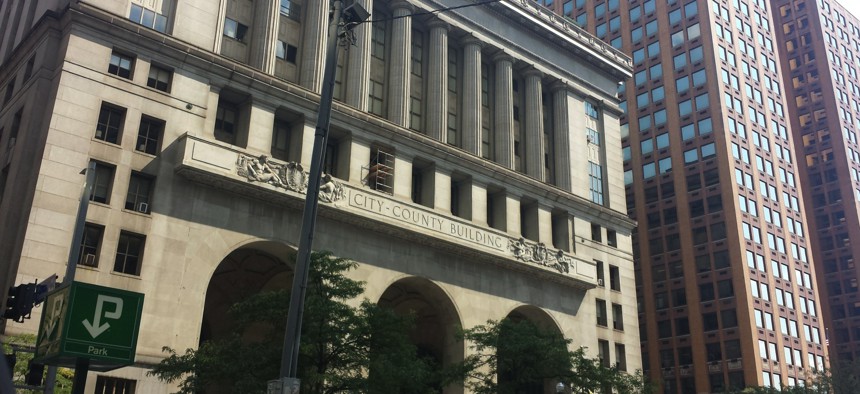Route Fifty City-County Roadtrip Recap: Pittsburgh and Allegheny County

The City-County Building in Pittsburgh Michael Grass / GovExec.com
The City-County Building is an impressive building, but in a city of towers, you could easily pass by without noticing.
Route Fifty is currently featuring dispatches from a city-county summer roadtrip in Maryland, West Virginia, Pennsylvania, Ohio, Michigan and elsewhere along the way. An Introduction to the Series | Previous Stop: Waynesburg, Pennsylvania | Next Stop: East Liverpool, Ohio
PITTSBURGH — In the varied landscape of cities and counties in the United States, there are certainly plenty of examples of unified city-county jurisdictions, e.g., the City and County of Denver and the City and County of San Francisco. So it makes sense that the seat of such a consolidated government would be under the same city-county roof. Denver and San Francisco both have magnificent municipal seats, both of which could be confused for a state capitol building.
But it’s much more of a rarity to be in a place where separate city and county governments would share the same physical seat of government. The City of Chicago and Cook County’s unified edifice—technically, two adjoining buildings on one square block in the Chicago Loop—is one such example.
Another is here in Pennsylvania’s second-largest city.
The seats of governments for the City of Pittsburgh and Allegheny County share the City-County Building. Driving around downtown Pittsburgh’s tight network of streets wedged between the Allegheny and Monongahela rivers, which form the Ohio River at Point State Park, it can be difficult to appreciate the grandness of the city’s dense Central Business District.
The best views of Pittsburgh’s skyline are, naturally, not downtown but from across the rivers—or from its many bridges heading into downtown. Mount Washington and Monongahela and Duquesne incline railroads, arguably, offer the most recognizable views of the city. And emerging from the Fort Pitt Tunnel onto the Fort Pitt Bridge with downtown suddenly opening up is, as I once wrote, “one of the most dramatic entries to a city anywhere in North America.”

Those are great views, for sure. But on the ground downtown, there’s so much packed into a very dense core and many of the downtown streets are narrow. You really have to look up from sidewalk level to take it all in and that’s not advisable when you’re driving.
Depending on which way you come, it’s easy to drive by the City-County Building without noticing. In a city of towers—the U.S. Steel Tower, Gulf Tower, PPG Place and the Cathedral of Learning, for example—the major seat of government(s) in Pittsburgh doesn’t necessarily stand out.
The City-County Building, designed by Henry Hornbostle and completed in 1917, sits on a downtown block bounded by Fourth and Forbes avenues and Grant and Ross streets. It’s not a towering structure compared to the rest of Pittsburgh’s downtown cityscape, but it does tower over adjacent streets.
Across Forbes Avenue is the Allegheny County Courthouse and Old Jail, the late 1880s government complex designed by Henry Hobson Richardson—the Boston architect who popularized a style of Romanesque Revival architecture that’s now named for him—stands out more with its heavy masonry, tower, arches, turrets and multi-gabled pitched roofs. It’s a structure that is attention-grabbing. There’s so much to look at.

The City-County Building, meanwhile, very much a Classical Revival edifice, is squarish and fills out the city block. If you’re walking by it on the sidewalk, you can’t really appreciate it in the same way you might be able to appreciate, say, San Francisco City Hall or the City and County Building in Denver.
In Pittsburgh, there’s no grand public space in front of it to appreciate the seat of government’s impressive Grant Street entrance with its three towering arches. (The surface parking lot across the street seems to be underutilized. Imagine a great public space that opened up in front of the City-County Building, though that could be difficult since Grant Street is an important thoroughfare for drivers headed to or from Interstate 376.)
Here are some archival photos of the City-County Building from the collections of the Library of Congress.



For my city-county roadtrip, it was good to check off the City-County Building in Pittsburgh from my planned itinerary. But I was on a time schedule and it was time to head back through the Fort Pitt Tunnel and continue westward.
Next Stop: East Liverpool, Ohio
Michael Grass is Executive Editor of Government Executive's Route Fifty.

NEXT STORY: An Innovative Law Enforcement Use of Garbage Trucks or Big Brother?






